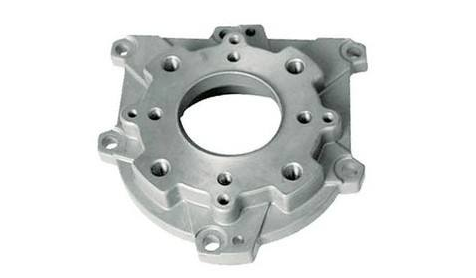Application Scope of Die Casting
December 28,2019
The die casting process is completed by a die casting machine. According to the working conditions of the pressure chamber, the die-casting machine is divided into two categories: hot-pressure chamber die-casting machine and cold-pressure chamber die-casting machine, and cold-pressure chamber die-casting machine is divided into horizontal and vertical types according to the layout of the pressure chamber. The basic processes of die casting of various die casting machines are mold clamping, injection, pressurization, pressure holding, and mold opening.

Application Scope of Die Casting
Die casting is an efficient, less and less cutting metal forming process that has developed rapidly in modern times. Due to the above-mentioned characteristics of die casting, this process method has been widely used in all walks of life in the national economy. In addition to being used in automobiles and motorcycles, instruments and meters, and industrial appliances, die castings are also widely used in household appliances, agricultural machinery, radio, communications, machine tools, transportation, shipbuilding, cameras, clocks, computers, textile equipment and other industries. Among them, automobile and motorcycle manufacturing are the most important application areas, with automobiles accounting for about 70% and motorcycles accounting for about 10%. Some of the die-casting parts currently produced are as small as a few grams, and the largest aluminum alloy castings have a mass of 50kg and a diameter of 2m.
There are various shapes of die castings, which can be roughly divided into six categories.
① Round cover - watch cover, machine cover, chassis, etc.
②Discs - No. disc seat, etc.
③ Rings - connectors, bearing retainers, steering wheels, etc.
④Cylinder type - flange jacket, conduit, shell-shaped cover, instrument cover, upper cover, deep cavity instrument cover, camera shell and cover, carburetor, etc.
⑤Porous cylinder blocks and shells - cylinder blocks, cylinder heads, oil pump bodies and other multi-cavity shells with complex structures (such parts have higher requirements on mechanical properties and air tightness, and the materials are generally aluminum alloys ), such as cylinder blocks and cylinder heads of automobiles and motorcycles.
Die casting is an efficient, less and less cutting metal forming process that has developed rapidly in modern times. Due to the above-mentioned characteristics of die casting, this process method has been widely used in all walks of life in the national economy. In addition to being used in automobiles and motorcycles, instruments and meters, and industrial appliances, die castings are also widely used in household appliances, agricultural machinery, radio, communications, machine tools, transportation, shipbuilding, cameras, clocks, computers, textile equipment and other industries. Among them, automobile and motorcycle manufacturing are the most important application areas, with automobiles accounting for about 70% and motorcycles accounting for about 10%. Some of the die-casting parts currently produced are as small as a few grams, and the largest aluminum alloy castings have a mass of 50kg and a diameter of 2m.
There are various shapes of die castings, which can be roughly divided into six categories.
① Round cover - watch cover, machine cover, chassis, etc.
②Discs - No. disc seat, etc.
③ Rings - connectors, bearing retainers, steering wheels, etc.
④Cylinder type - flange jacket, conduit, shell-shaped cover, instrument cover, upper cover, deep cavity instrument cover, camera shell and cover, carburetor, etc.
⑤Porous cylinder blocks and shells - cylinder blocks, cylinder heads, oil pump bodies and other multi-cavity shells with complex structures (such parts have higher requirements on mechanical properties and air tightness, and the materials are generally aluminum alloys ), such as cylinder blocks and cylinder heads of automobiles and motorcycles.
⑥Special shapes - impellers, horns, decorative die-castings whose fonts are composed of ribs, etc.
Alloys such as aluminum, zinc, magnesium and copper are currently produced by die casting. Due to the lack of ideal high temperature resistant mold materials, the die-casting of ferrous alloys is still in the stage of small-scale experimental research and has not been able to be produced on an industrial scale. In the die casting of non-ferrous alloys, aluminum alloys account for the highest proportion, accounting for 60% to 80%. Zinc alloy is second, accounting for 10% to 20%. In foreign countries, zinc alloy castings were rarely used in the past, and were used in forestry machinery, less than 1%. However, in recent years, with the development of the automobile industry, the electronic communication industry and the requirements of lightweight products, coupled with the recent improvement of magnesium alloy die-casting technology, the magnesium alloy die-casting market has attracted much attention. It can be expected that with the increasing depletion of metal mineral resources, magnesium alloy materials, known as "green engineering materials in the 21st century", will be used in automobiles, 3C (computers-computers, communications-communication equipment and consumer electronics- -Consumer electronics) products, aerospace, national defense and other fields have more and more important application value and broad application prospects.
Alloys such as aluminum, zinc, magnesium and copper are currently produced by die casting. Due to the lack of ideal high temperature resistant mold materials, the die-casting of ferrous alloys is still in the stage of small-scale experimental research and has not been able to be produced on an industrial scale. In the die casting of non-ferrous alloys, aluminum alloys account for the highest proportion, accounting for 60% to 80%. Zinc alloy is second, accounting for 10% to 20%. In foreign countries, zinc alloy castings were rarely used in the past, and were used in forestry machinery, less than 1%. However, in recent years, with the development of the automobile industry, the electronic communication industry and the requirements of lightweight products, coupled with the recent improvement of magnesium alloy die-casting technology, the magnesium alloy die-casting market has attracted much attention. It can be expected that with the increasing depletion of metal mineral resources, magnesium alloy materials, known as "green engineering materials in the 21st century", will be used in automobiles, 3C (computers-computers, communications-communication equipment and consumer electronics- -Consumer electronics) products, aerospace, national defense and other fields have more and more important application value and broad application prospects.